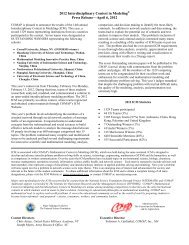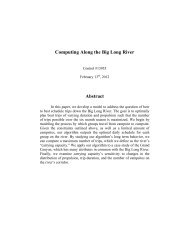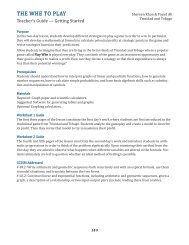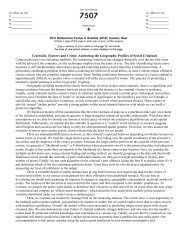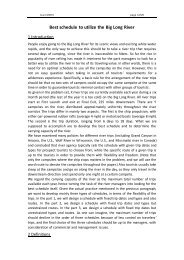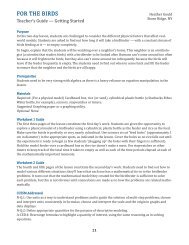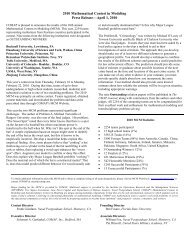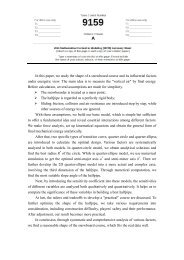You also want an ePaper? Increase the reach of your titles
YUMPU automatically turns print PDFs into web optimized ePapers that Google loves.
Volume 42/Number 12/December 2001<br />
Fig. 2 Abundance and mass of plankton and plastic in night versus<br />
day samples.<br />
during the day than at night, although much of the<br />
di€erence during the day was due to a plastic bottle<br />
being caught in one daylight sample and 1 m of polypropylene<br />
line being caught in the other.<br />
Discussion<br />
<strong>The</strong> mean abundance and weight of plastic pieces<br />
calculated for this study are the largest observed in the<br />
North Paci®c <strong>Ocean</strong>. Previous studies have estimated<br />
mean abundances of plastic pieces ranging from 3370 to<br />
96100 pieces km 2 and mean weights ranging from 46 to<br />
1210 gkm 2 Day and Shaw, 1987). <strong>The</strong> highest previous<br />
single sample abundance and weight recorded for the<br />
North Paci®c <strong>Ocean</strong> was taken from an area about 500<br />
miles east of Japan. At 316800 pieces km 2 and<br />
3492 gkm 2 Day et al., 1990), the abundance and<br />
weight are three and seven times less than the highest<br />
sample recorded in this study, respectively.<br />
Several possible reasons are suggested for the high<br />
abundance found in this study. <strong>The</strong> ®rst is the location<br />
of our study area, which was near the central of the<br />
North Paci®c subtropical high pressure cell. Previous<br />
studies in the North Paci®c <strong>Ocean</strong> were conducted<br />
without reference to the central pressure cell Day et al.,<br />
1990), which should serve as a natural eddy system to<br />
concentrate neustonic material including plastic. However,<br />
while previous studies did not focus on the subtropical<br />
high, many studies were conducted as transects<br />
that passed through the gyre Day et al., 1986, 1988,<br />
1990). Thus, it is unlikely that location alone was the<br />
reason for the higher densities we observed, as Day et al.<br />
1990) collected samples from the western part of this<br />
same area.<br />
An alternate hypothesis is that the amount of plastic<br />
material in the ocean is increasing over time, which Day<br />
and Shaw 1987) have previously suggested based upon<br />
a review of historical studies. Plastic degrades slowly in<br />
the ocean Andrady, 1990; US EPA, 1992). While some<br />
of the larger pieces may accumulate enough fouling<br />
organisms to sink them, the smaller pieces are usually<br />
free of fouling organisms and remain a¯oat. Thus, new<br />
plastics added to the ocean may not exit the system once<br />
introduced unless they are washed ashore. Although<br />
numerous studies have shown that islands are repositories<br />
of marine debris Lucas, 1992; Corbin and Singh,<br />
1993; Walker et al., 1997), the North Paci®c <strong>Ocean</strong> has<br />
few islands except near coastal boundaries. <strong>The</strong> dominant<br />
clockwise gyral currents also serve as a retention<br />
mechanism that inhibits plastics from moving toward<br />
mainland coasts. A recent surface current modeling<br />
study simulated that most of the particles from our<br />
sampling area should be retained there for at least 12<br />
years Ingraham et al., in press).<br />
<strong>The</strong> large ratio of plasticto plankton found in this<br />
study has the potential to a€ect many types of biota.<br />
Most susceptible are the birds and ®lter feeders that<br />
focus their feeding activities on the photic portion of the<br />
water column. Many birds have been examined and<br />
found to contain small debris in their stomachs, a result<br />
of their mistaking plasticfor food Day et al., 1985; Fry<br />
et al., 1987; Ainley et al., 1990; Ogi, 1990; Ryan, 1990;<br />
Laist, 1997). While no record was kept of the presence<br />
or absence of fouling organisms on plastic particles<br />
during sorting, a subsequent random sampling of each<br />
size class found 91.5% of the particles to be free of<br />
fouling organisms. As the size class decreased, there<br />
were fewer particles that showed evidence of fouling.<br />
Hence ingestion of plastic for its attached food seems<br />
unlikely, especially for organisms feeding on the surface.<br />
However, organisms such as the two ®lter-feeding salps<br />
<strong>The</strong>tys vagina) collected in this study which were found<br />
to have plasticfragments and polypropylene/mono®lament<br />
line ®rmly embedded in their tissues, may have<br />
ingested the line at depth and utilized fouling organisms<br />
for food.<br />
Although our study focused on the neuston, samples<br />
also were collected from two oblique tows to a depth of 10<br />
m. We found that the density of plasticin these areas was<br />
less than half of that in the surface waters and was primarily<br />
limited to mono®lament line that had been fouled<br />
by diatoms and microalgae, thereby reducing its buoyancy.<br />
<strong>The</strong> smaller particles that have the greatest potential<br />
to a€ect ®lter feeders were even more reduced with<br />
depth, as should be expected because of their positive<br />
buoyancy and lack of fouling organisms, noted above.<br />
Several limitations restrict our ability to extrapolate<br />
our ®ndings of high plastic-to-plankton ratios in the<br />
1299







